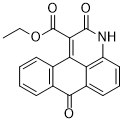NQDI-1
This product is for research use only, not for human use. We do not sell to patients.

For small sizes, please check our retail website as below: www.invivochem.com
| Size | Price | Stock |
|---|---|---|
| 250mg | $850 | Check With Us |
| 500mg | $1550 | Check With Us |
| 1g | $2325 | Check With Us |
Cat #: V26656 CAS #: 175026-96-7 Purity ≥ 99%
Description: NQDI-1 is a novel and potent inhibitor of ASK1.
Top Publications Citing Invivochem Products
Publications Citing InvivoChem Products
Product Promise

- Physicochemical and Storage Information
- Protocol
- Related Biological Data
- Stock Solution Preparation
- Quality Control Documentation
| Molecular Weight (MW) | 319.31 |
|---|---|
| Molecular Formula | C19H13NO4 |
| CAS No. | 175026-96-7 |
| SMILES Code | O=C(C1=C2C3=C(NC1=O)C=CC=C3C(C4=C2C=CC=C4)=O)OCC |
| Synonyms | NQDI1; NQDI-1; NQDI 1 |
| Protocol | In Vitro | The selectivity of NQDI-1 is evaluated in vitro on four serine/threonine protein kinases (protein kinase CK2 (CK2), c-Jun N-terminal kinase 3 (JNK3), Rho-associated protein kinase 1 (Rock1), and Aurora A) and three tyrosine protein kinases (FGFR1, hHGFR, and endothelial TEK tyrosine kinase (Tie2)). The results show that NQDI-1 is a selective inhibitor of ASK1. The activity of FGFR1 protein kinase is inhibited by NQDI-1 (residual activity of 44%). NQDI-1 inhibits ASK1 with a Ki of 500 nM. Inhibition of ASK1 by NQDI-1 is competitive with respect to the phosphodonor substrate ATP. |
|---|---|---|
| In Vivo | 250 nmol NQDI-1 in DMSO is intracerebroventricularly injected following brain insult. Western blotting is performed to determine the expression of ASK1 in the sham, Hypoxia-ischemia (HI), DMSO and NQDI-1 groups and indicate that NQDI-1 markedly inhibits the expression of ASK1 in the brain cortex, compared with the HI and DMSO group. Furthermore, immunofluorescence staining also indicates that the expression of ASK1 is inhibited by NQDI-1 in the brain cortex. The expression of downstream targets of ASK1 is also determined in the present study. The expression levels of p-JNK, p-c-Jun, p53 and caspase 3 are significantly decreased by NQDI-1, compared with the HI and DMSO groups. Low expression of p-JNK in the brain cortex is also observed by immunofluorescence in the NQDI-1-treated group. |
These protocols are for reference only. InvivoChem does not
independently validate these methods.
| Solvent volume to be added | Mass (the weight of a compound) | |||
|---|---|---|---|---|
| Mother liquor concentration | 1mg | 5mg | 10mg | 20mg |
| 1mM | 3.1318 mL | 15.6588 mL | 31.3175 mL | 62.6351 mL |
| 5mM | 0.6264 mL | 3.1318 mL | 6.2635 mL | 12.5270 mL |
| 10mM | 0.3132 mL | 1.5659 mL | 3.1318 mL | 6.2635 mL |
| 20mM | 0.1566 mL | 0.7829 mL | 1.5659 mL | 3.1318 mL |
The molarity calculator equation
Mass(g) = Concentration(mol/L) × Volume(L) × Molecular Weight(g/mol)
Mass
=
Concentration
×
Volume
×
Molecular Weight*
The dilution calculator equation
Concentration(start)
×
Volume(start)
=
Concentration(final)
×
Volume(final)
This equation is commonly abbreviated as: C1 V1 = C2 V2
Concentration(start)
C1
×
Volume(start)
V1
=
Concentration(final)
C2
×
Volume(final)
V2
Step One: Enter information below
Dosage mg/kg
Average weight of animals g
Dosing volume per animal µL
Number of animals
Step Two: Enter the in vivo formulation
%DMSO
+
%
+
%Tween 80
+
%ddH2O
Calculation Results:
Working concentration:
mg/ml;
Method for preparing DMSO master liquid:
mg
drug pre-dissolved in
µL
DMSO(Master liquid concentration
mg/mL)
,Please contact us first if the concentration exceeds the DMSO solubility of the batch of drug.
Method for preparing in vivo formulation:
Take
µL
DMSO master liquid, next add
µL
PEG300, mix and clarify, next add
µL
Tween 80,mix and clarify, next add
µL
ddH2O,mix and clarify.
Note:
- (1) Please be sure that the solution is clear before the addition of next solvent. Dissolution methods like vortex, ultrasound or warming and heat may be used to aid dissolving.
- (2) Be sure to add the solvent(s) in order.




































